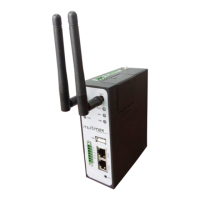RIP (Routing Information Protocol) is a distance-vector routing
protocol, which employs the hop count as a routing metric. RIP
prevents routing loops by implementing a limit on the number of hops
allowed in a path from the source to a destination.
Enable RIP
Protocol
Setting
Tick to enable RIP function.
Select from “RIPv1” and “RIPv2”.
If you input this neighbor IP, router will only send RIP request massage
to this IP instead of broadcast. This item only needs to be set in some
unicast network.
Defines the interval between routing updates.
Defines the route aging time. If no update for a route is received after
the aging time elapses, the metric of the route is set to 16 in the
routing table.
Defines the interval from when the metric of a route becomes 16 to
when it is deleted from the routing table. During the Garbage-Collect
timer length, RIP advertises the route with the routing metric set to 16. If
no update is announced for that route after the Garbage-Collect
timer expires, the route will be deleted from the routing table.
Tick to enable RIP protocol Advance Setting.
This value is used for redistributed routes.
The first criterion that a router uses to determine which routing
protocol to use if two protocols provide route information for the same
destination.
Select from “None”, “Eth0”, “Eth1” and “Default”.
This command sets the specified interface to passive mode. On
passive mode interface, all receiving packets are processed as
normal and Rip info does not send either multicast or unicast RIP
packets except to RIP neighbors specified with neighbor command.
The default is to be passive on all interfaces.

